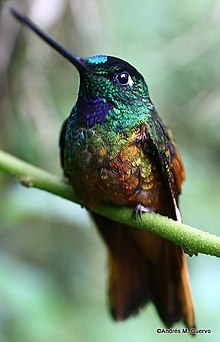Golden-tailed starfrontlet
| Golden-tailed starfrontlet | |
|---|---|

| |
| Scientific classification | |
| Domain: | Eukaryota |
| Kingdom: | Animalia |
| Phylum: | Chordata |
| Class: | Aves |
| Clade: | Strisores |
| Order: | Apodiformes |
| Family: | Trochilidae |
| Genus: | Coeligena |
| Species: | C. eos
|
| Binomial name | |
| Coeligena eos (Gould, 1848)
| |
| Synonyms | |
| |
The golden-tailed starfrontlet (Coeligena eos) is a species of hummingbird in the "brilliants", tribe Heliantheini in subfamily Lesbiinae. It is endemic to Venezuela. It is also called the Merida starfrontlet and golden starfrontlet.[3][4][5]
Taxonomy and systematics
The golden-bellied starfrontlet and most other members of genus Coeligena were at one time placed in genus Helianthea but have been in their current placement since the mid-1900s.
Description
The golden-tailed starfrontlet is about 11.4 cm (4.5 in) long including its 3.0 cm (1.2 in) bill. Males weigh about of 6.8 g (0.24 oz) and females 6.4 g (0.23 oz). Both sexes have a white spot behind the eye. Adult males have a blackish crown with a glittering green forehead. Their upper back is shining golden green that transitions to the gold to golden orange rump. The throat and breast are glittering green and the throat has a small violet patch. The rest of the underparts are variable, from glittering coppery red to reddish gold. The undertail
Distribution and habitat
The golden-tailed starfrontlet is found in the Andes of western Venezuela between the states of
Behavior
Movement
The golden-tailed starfrontlet apparently moves to higher elevation during the rainy season.[7]
Feeding
The golden-tailed starfrontlet gathers nectar from long tubular flowers, usually of low to medium height. It has been observed feeding at Ericaceae and at plants of genera Centropogon and Fuchsia. In addition to feeding on nectar it captures small arthropods by gleaning from foliage, hovering, and by hawking.[7]
Breeding
The golden-tailed starfrontlet's breeding season appears to be from January to March. It makes a cup nest of moss, lichens, and rootlets lined with softer plant material, and typically attaches it to a vertical branch within vegetation. Nothing else is known about its breeding biology.[7]
Vocalization
As of early 2023 neither xeno-canto nor the Cornell Lab of Ornithology's Macaulay Library had any recordings of the golden-tailed starfrontlet's vocalizations.
Status
The
References
- ^ . Retrieved 1 February 2023.
- ^ "Appendices | CITES". cites.org. Retrieved 2023-02-01.
- ^ a b Gill, F.; Donsker, D.; Rasmussen, P., eds. (January 2023). "Hummingbirds". IOC World Bird List. v 13.1. Retrieved January 30, 2023.
- ^ a b HBW and BirdLife International (2022) Handbook of the Birds of the World and BirdLife International digital checklist of the birds of the world. Version 7. Available at: http://datazone.birdlife.org/userfiles/file/Species/Taxonomy/HBW-BirdLife_Checklist_v7_Dec22.zip retrieved December 13, 2022
- ^ a b Clements, J. F., T. S. Schulenberg, M. J. Iliff, T. A. Fredericks, J. A. Gerbracht, D. Lepage, S. M. Billerman, B. L. Sullivan, and C. L. Wood. 2022. The eBird/Clements checklist of birds of the world: v2022. Downloaded from https://www.birds.cornell.edu/clementschecklist/download/ retrieved November 10, 2022
- ^ a b Remsen, J. V., Jr., J. I. Areta, E. Bonaccorso, S. Claramunt, A. Jaramillo, D. F. Lane, J. F. Pacheco, M. B. Robbins, F. G. Stiles, and K. J. Zimmer. Version 30 January 2023. A classification of the bird species of South America. American Ornithological Society. https://www.museum.lsu.edu/~Remsen/SACCBaseline.htm retrieved January 30, 2023
- ^ a b c d e f Palacios, C. (2022). Merida Starfrontlet (Coeligena eos), version 1.0. In Birds of the World (N. D. Sly and S. M. Billerman, Editors). Cornell Lab of Ornithology, Ithaca, NY, USA. https://doi.org/10.2173/bow.gobsta4.01 retrieved February 1, 2023

